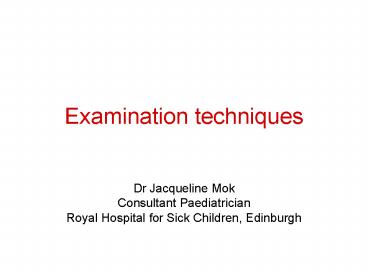Examination techniques - PowerPoint PPT Presentation
1 / 10
Title:
Examination techniques
Description:
Superficial injuries - head and neck, mouth, breasts, arms, inner thighs, ... labial separation - good view of labia, vestibule and posterior fourchette ... – PowerPoint PPT presentation
Number of Views:417
Avg rating:3.0/5.0
Title: Examination techniques
1
Examination techniques
- Dr Jacqueline Mok
- Consultant Paediatrician
- Royal Hospital for Sick Children, Edinburgh
2
CSA examination
- Behaviour,demeanour, emotional state
- Appropriate for age?
- State of clothing
- Sexual development
- Superficial injuries - head and neck, mouth,
breasts, arms, inner thighs, buttocks, perineum,
genitalia, anus - Detailed exam using colposcope
3
Examination techniques
- Supine frog-leg
- On examination couch, alone or lying against
mother - Inspection
- Labial separation
- Labial traction
4
Examination techniques
- Supine frog-leg
- Defining the anatomy of a fimbriated hymen
- Floating with saline
- Teasing with cotton bud
- Foley catheter
5
Examination techniques
- Supine knee-chest
- For anal examination
- Left lateral
- For anal examination
- Prone knee-chest
- For clarification of doubtful findings on hymen
6
Comparison of techniques
- Supine labial separation - good view of labia,
vestibule and posterior fourchette - Supine labial traction - largest transverse
diameter - Prone knee-chest - largest vertical diameter
McCann,1990,Pediatr
7
Hymenal diameter depends on
- age / stage of puberty
- position during examination
- degree of traction applied
- degree of relaxation of child
- examination under GA
- hymenal morphology
- time between abuse and exam
8
Documentation of visual evidence
- Written notes not always legible
- Drawings - subjective, difficult to challenge
- Photographs / slides - objective, dependent on
examiners choice - Videotapes / CDs - dynamic variability of the
entire examination
9
Video-colposcopy
- Immediate viewing on monitor
- Dynamic 3-D procedure recorded on tape / CD
- Playback for review
- Images captured on photographs or slides
- Digitalised for computer analysis
10
Relate findings to
- Time of examination in relation to assault
- Examination position and state of child
- Examination technique abnormality must be
demonstrated in gt1 position or gt1 method - Duration of examination (eg venous pooling
appearing after 1 minute) - Relevant medical history































